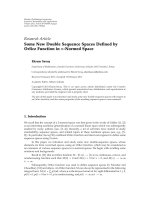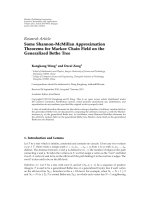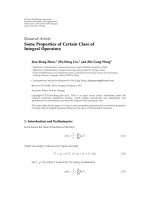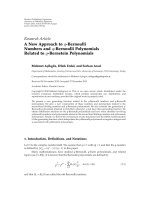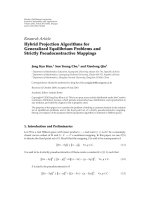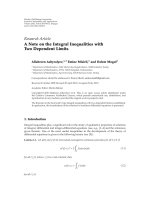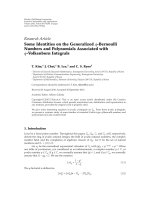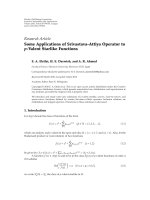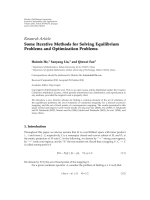Báo cáo hóa học: " Research Article Some Identities on the Generalized q-Bernoulli Numbers and Polynomials Associated with q-Volkenborn Integrals" docx
Bạn đang xem bản rút gọn của tài liệu. Xem và tải ngay bản đầy đủ của tài liệu tại đây (531.42 KB, 17 trang )
Hindawi Publishing Corporation
Journal of Inequalities and Applications
Volume 2010, Article ID 575240, 17 pages
doi:10.1155/2010/575240
Research Article
Some Identities on the Generalized q-Bernoulli
Numbers and Polynomials Associated with
q-Volkenborn Integrals
T. Kim,
1
J. Choi,
1
B. Lee,
2
and C. S. Ryoo
3
1
Division of General Education-Mathematics, Kwangwoon University, Seoul 139-701, Republic of Korea
2
Department of Wireless Communications Engineering, Kwangwoon University,
Seoul 139-701, Republic of Korea
3
Department of Mathematics, Hannam University, Daejeon 306-791, Republic of Korea
Correspondence should be addressed to T. Kim,
Received 23 August 2010; Accepted 30 September 2010
Academic Editor: Alberto Cabada
Copyright q 2010 T. Kim et al. This is an open access article distributed under the Creative
Commons Attribution License, which permits unrestricted use, distribution, and reproduction in
any medium, provided the original work is properly cited.
We give some interesting equation of p-adic q-integrals on
Z
p
. From those p-adic q-integrals,
we present a systemic study of some families of extended Carlitz type q-Bernoulli numbers and
polynomials in p-adic number field.
1. Introduction
Let p be a fixed prime number. Throughout this paper, Z
p
, Q
p
, C,andC
p
will, respectively,
denote the ring of p-adic rational integer, the field of p-adic rational numbers, the complex
number field, and the completion of algebraic closure of Q
p
.LetN be the set of natural
numbers and Z
{0}∪N.
Let ν
p
be the normalized exponential valuation of C
p
with |p|
p
p
−ν
p
p
p
−1
. When
one talks of q-extension, q is considered as an indeterminate, a complex number q ∈ C, or
p-adic number q ∈ C
p
. If q ∈ C, we normally assume that |q| < 1, and if q ∈ C
p
, we normally
assume that |1 − q|
p
< 1. We use the notation
x
q
1 − q
x
1 − q
. 1.1
The q-factorial is defined as
n
q
!
n
q
n − 1
q
···
2
q
1
q
,
1.2
2 Journal of Inequalities and Applications
and the Gaussian q-binomial coefficient is defined by
n
k
q
n
q
!
n − k
q
!
k
q
!
n
q
n − 1
q
···
n − k 1
q
k
q
!
,
1.3
see 1.Notethat
lim
q → 1
n
k
q
n
k
n
n − 1
···
n − k 1
k!
.
1.4
From 1.3,weeasilyseethat
n 1
k
q
n
k − 1
q
q
k
n
k
q
q
n1−k
n
k − 1
q
n
k
q
,
1.5
see 2, 3. For a fixed positive integer f, f, p1, let
X X
f
lim
←−
N
Z
fp
N
Z
,X
1
Z
p
,
X
∗
0<a<fp
a,p
1
a fpZ
p
,a fp
N
Z
p
x ∈ X | x ≡ a
modfp
N
,
1.6
where a ∈ Z and 0 ≤ a<fp
N
see 1–14.
We say that f is a uniformly differential function at a point a ∈ Z
p
and denote this
property by f ∈ UDZ
p
if the difference quotients
F
f
x, y
f
x
− f
y
x − y
1.7
have a limit l f
a as x, y → a, a. For f ∈ UDZ
p
, let us begin with the expression
1
p
N
q
p
N
−1
x0
f
x
q
x
0≤x<p
N
f
x
μ
q
x p
N
Z
p
,
1.8
representing a q-analogue of the Riemann sums for f, see 1–3, 11–18. The integral of f
Journal of Inequalities and Applications 3
on Z
p
is defined as the limit N →∞ of the sums if exists.Thep-adic q-integral q-
Volkenborn integral of f ∈ UDZ
p
is defined by
I
q
f
X
f
x
dμ
q
x
Z
p
f
x
dμ
q
x
lim
N−→ ∞
1
p
N
q
0≤x<p
N
f
x
q
x
,
1.9
see 12. Carlitz’s q-Bernoull numbers β
k,q
can be defined recursively by β
0,q
1andbythe
rule that
q
qβ
∗
1
k
− β
∗
k,q
⎧
⎨
⎩
1, if k 1,
0, if k>1,
1.10
with the usual convention of replacing β
∗
i
by β
∗
i,q
, see 1–13.
It is well known that
β
∗
n,q
Z
p
x
n
q
dμ
q
x
X
x
n
q
dμ
q
x
,n∈ Z
,
β
∗
n,q
x
Z
p
y x
n
q
dμ
q
y
X
y x
n
q
dμ
q
y
,n∈ Z
,
1.11
see 1, where β
∗
n,q
x are called the nth Carlitz’s q-Bernoulli polynomials see 1, 12, 13.
Let χ be the Dirichlet’s character with conductor f ∈ N, then the generalized Carlitz’s
q-Bernoulli numbers attached to χ are defined as follows:
β
∗
n,χ,q
X
χ
x
x
n
q
dμ
q
x
,
1.12
see 13. Recently, many authors have studied in the different several areas related to q-
theory see 1–13. In this paper, we present a systemic study of some families of multiple
Carlitz’s type q-Bernoulli numbers and polynomials by using the integral equations of p-adic
q-integrals on Z
p
. First, we derive some interesting equations of p-adic q-integrals on Z
p
.
From these equations, we give some interesting formulae for the higher-order Carlitz’s type
q-Bernoulli numbers and polynomials in the p-adic number field.
2. On the Generalized Higher-Order q-Bernoulli Numbers
and Polynomials
In this section, we assume that q ∈ C
p
with |1 − q|
p
< 1. We first consider the q-extension of
Bernoulli polynomials as follows:
∞
n0
β
n,q
x
t
n
n!
Z
p
q
−y
e
xy
q
t
dμ
q
y
−t
∞
m0
e
xm
q
t
q
xm
.
2.1
4 Journal of Inequalities and Applications
From 2.1,wenotethat
β
n,q
x
1
1 − q
n
n
l0
n
l
−q
x
l
l
l
q
1
1 − q
n−1
n
l0
n
l
−q
x
l
l
1 − q
l
n
1 − q
n−1
n−1
l0
n − 1
l
q
l1x
1
1 − q
l1
−1
l1
−n
1 − q
n−1
∞
m0
q
mx
n−1
l0
n − 1
l
q
lxm
−n
∞
m0
q
mx
x m
n−1
q
.
2.2
Note that
lim
q → 1
β
n,q
x
−n
∞
m0
x m
n−1
B
n
x
,
2.3
where B
n
x are called the n th ordinary Bernoulli polynomials. In the special case, x 0,
β
n,q
0β
n,q
are called the n th q-Bernoulli numbers.
By 2.2, we have the following lemma.
Lemma 2.1. For n ≥ 0, one has
β
n,q
x
Z
p
q
−y
x y
n
q
dμ
q
y
−n
∞
m0
q
mx
x m
n−1
q
1
1 − q
n
n
l0
n
l
−q
x
l
l
l
q
.
2.4
Now, one considers the q-Bernoulli polynomials of order r ∈ N as follows:
∞
n0
β
r
n,q
x
t
n
n!
Z
p
···
Z
p
r times
q
−x
1
···x
r
e
xx
1
···x
r
q
t
dμ
q
x
1
···dμ
q
x
r
.
2.5
Journal of Inequalities and Applications 5
By 2.5, one sees that
β
r
n,q
x
Z
p
···
Z
p
r times
q
−x
1
···x
r
x x
1
··· x
r
n
q
dμ
q
x
1
···dμ
q
x
r
1
1 − q
n
n
l0
n
l
−1
l
q
xl
l
l
q
r
.
2.6
In the special case, x 0, the sequence β
r
n,q
0β
r
n,q
is refereed to as the q-extension of Bernoulli
numbers of order r. For f ∈ N, one has
β
r
n,q
x
X
···
X
r times
q
−x
1
···x
r
x x
1
··· x
r
n
q
dμ
q
x
1
···dμ
q
x
r
1
1 − q
n
n
l0
n
l
−1
l
f−1
a
1
, ,a
r
0
q
lxa
1
···a
r
l
r
lf
r
q
f
n−r
q
f−1
a
1
, ,a
r
0
β
r
n,q
f
a
1
··· a
r
x
f
.
2.7
By 2.5 and 2.7, one obtains the following theorem.
Theorem 2.2. For r ∈ Z
,f ∈ N, one has
β
r
n,q
x
1
1 − q
n
n
l0
f−1
a
1
, ,a
r
0
n
l
−1
l
q
la
1
···a
r
x
l
r
lf
r
q
f
n−r
q
f−1
a
1
, ,a
r
0
β
r
n,q
f
a
1
··· a
r
x
f
.
2.8
Let χ be the primitive Dirichlet’s character with conductor f ∈ N, then the generalized q-
Bernoulli polynomials attached to χ are defined by
∞
n0
β
n,χ,q
x
t
n
n!
X
χ
y
q
−y
e
xy
q
t
dμ
q
y
.
2.9
6 Journal of Inequalities and Applications
From 2.9, one derives
β
n,χ,q
x
X
χ
y
q
−y
x y
n
q
dμ
q
y
f−1
a0
χ
a
lim
N−→ ∞
1
fp
N
q
fp
N
−1
y0
a x fy
n
q
1
1 − q
n
f−1
a0
χ
a
n
l0
n
l
−1
l
q
lxa
l
lf
q
f−1
a0
χ
a
∞
m0
−n
x a mf
n−1
q
−n
∞
m0
χ
m
x m
n−1
q
.
2.10
By 2.9 and 2.10, one can give the generating function for the generalized q-Bernoulli polynomials
attached to χ as follows:
F
χ,q
x,t
−t
∞
m0
χ
m
e
xm
q
t
∞
n0
β
n,χ,q
x
t
n
n!
.
2.11
From 1.3, 2.10, and 2.11, one notes that
β
n,χ,q
x
1
f
q
f−1
a0
χ
a
Z
p
q
−fy
a x fy
n
q
dμ
q
f
y
f
n−1
q
f−1
a0
χ
a
β
n,q
f
a x
f
.
2.12
In the special case, x 0, the sequence β
n,χ,q
0β
n,χ,q
are called the n th generalized q-
Bernoulli numbers attached to χ.
Let one consider the higher-order q-Bernoulli polynomials attached to χ as follows:
X
···
X
r times
r
i1
χ
x
i
e
xx
1
···x
r
q
t
q
−x
1
···x
r
dμ
q
x
1
···dμ
q
x
r
∞
n0
β
r
n,χ,q
x
t
n
n!
,
2.13
where β
r
n,χ,q
x are called the n th generalized q-Bernoulli polynomials of order r attaches to χ.
Journal of Inequalities and Applications 7
By 2.13, one sees that
β
r
n,χ,q
x
1
1 − q
n
n
l0
n
l
−q
x
l
f−1
a
1
, ,a
r
0
r
i1
χ
a
i
q
l
r
i1
a
i
l
r
lf
r
q
f
n−r
q
f−1
a
1
, ,a
r
0
r
i1
χ
a
i
β
r
n,q
f
x a
1
··· a
r
f
.
2.14
In the special case, x 0, the sequence β
r
n,χ,q
0β
r
n,χ,q
are called the n th generalized q-Bernoulli
numbers of order r attaches to χ.
By 2.13 and 2.14, one obtains the following theorem.
Theorem 2.3. Let χ be the primitive Dirichlet’s character with conductor f ∈ N. For n ∈ Z
,r ∈ N,
one has
β
r
n,χ,q
x
1
1 − q
n
n
l0
n
l
−q
x
l
f−1
a
1
, ,a
r
0
r
i1
χ
a
i
q
l
r
i1
a
i
l
r
lf
r
q
f
n−r
q
f−1
a
1
, ,a
r
0
r
i1
χ
a
i
β
r
n,q
f
x a
1
··· a
r
f
.
2.15
For h ∈ Z, and r ∈ N, one introduces the extended higher-order q-Bernoulli polynomials as
follows:
β
h,r
n,q
x
Z
p
···
Z
p
r times
q
r
j1
h−j−1x
j
x x
1
··· x
r
n
q
dμ
q
x
1
···dμ
q
x
r
.
2.16
From 2.16, one notes that
β
h,r
n,q
x
1
1 − q
n
n
l0
n
l
−1
l
q
lx
lh−1
r
lh−1
r
q
r!
r
q
!
,
2.17
and
β
h,r
n,q
x
f
n−r
q
f−1
a
1
, ,a
r
0
q
r
j1
h−ja
j
β
h,r
n,q
f
x a
1
··· a
r
f
.
2.18
In the special case, x 0, β
h,r
n,q
0β
h,r
n,q
are called the n th h, q-Bernoulli numbers of order
r.
By 2.17, one obtains the following theorem.
8 Journal of Inequalities and Applications
Theorem 2.4. For h ∈ Z,r ∈ N, one has
β
h,r
n,q
x
1
1 − q
n
n
l0
n
l
−q
x
l
lh−1
r
lh−1
r
q
r!
r
q
!
,
β
h,r
n,q
x
f
n−r
q
f−1
a
1
, ,a
r
0
q
r
j1
h−ja
j
β
h,r
n,q
f
x a
1
··· a
r
f
.
2.19
Let χ be the primitive Dirichlet’s character with conductor f ∈ N, then one considers the
generalized h, q-Bernoulli polynomials attached to χ of order r as follows:
β
h,r
n,χ,q
x
X
···
X
r times
q
r
j1
h−j−1x
j
⎛
⎝
r
j1
χ
x
j
⎞
⎠
x x
1
··· x
r
n
q
dμ
q
x
1
···dμ
q
x
r
.
2.20
By 2.20, one sees that
β
h,r
n,χ,q
x
f
n−r
q
f−1
a
1
, ,a
r
0
q
r
j1
h−ja
j
⎛
⎝
r
j1
χ
a
j
⎞
⎠
β
h,r
n,q
f
x a
1
··· a
r
f
. 2.21
In the special case, x 0, β
h,r
n,χ,q
0β
h,r
n,χ,q
are called the n th generalized h, q-Bernoulli numbers
attached to χ of order r.
From 2.20 and 2.21, one notes that
β
h,r
n,χ,q
q − 1
β
h−1,r
n1,χ,q
β
h−1,r
n,χ,q
.
2.22
By 2.16, it is easy to show that
β
h,r
n,χ,q
Z
p
···
Z
p
r times
x
1
··· x
r
n
q
q
r
j1
h−j−1x
j
dμ
q
x
1
···dμ
q
x
r
Z
p
···
Z
p
x
1
··· x
r
n
q
x
1
··· x
r
q
q − 1
1
q
r
j1
h−j−2x
j
dμ
q
x
1
···dμ
q
x
r
.
2.23
Thus, one has
β
h,r
n,q
q − 1
β
h−1,r
n1,q
β
h−1,r
n,q
.
2.24
Journal of Inequalities and Applications 9
From 2.16 and 2.23, one can also derive
Z
p
···
Z
p
r times
q
n−2x
1
n−3x
2
···n−r−1x
r
dμ
q
x
1
···dμ
q
x
r
Z
p
···
Z
p
q
−x
1
···x
r
q
nx
1
···x
r
q
−x
1
−2x
2
−···−rx
r
dμ
q
x
1
···dμ
q
x
r
n
l0
n
l
q − 1
l
Z
p
···
Z
p
x
1
··· x
r
l
q
q
−x
1
···x
r
q
−x
1
−2x
2
−···−rx
r
dμ
q
x
1
···dμ
q
x
r
n
l0
n
l
q − 1
l
β
0,r
l,q
,
Z
p
···
Z
p
q
n−2x
1
n−3x
2
···n−r−1x
r
dμ
q
x
1
···dμ
q
x
r
n−1
r
n−1
r
q
r!
r
q
!
.
2.25
It is easy to see that
n
j0
n
j
q − 1
j
Z
p
x
j
q
q
h−2x
dμ
q
x
Z
p
q − 1
x
q
1
n
q
h−2x
dμ
q
x
n h − 1
n h − 1
q
.
2.26
By 2.23, 2.25,and2.26, one obtains the following theorem.
Theorem 2.5. For h ∈ Z,r ∈ N, and n ∈ Z
, one has
β
h,r
n,q
q − 1
β
h−1,r
n1,q
β
h−1,r
n,q
,
n
l0
n
l
q − 1
l
β
0,r
l,q
n−1
r
n−1
r
q
r!
r
q
!
.
2.27
Furthermore, one gets
n
l0
n
l
q − 1
l
β
h,1
l,q
n h − 1
n h − 1
q
.
2.28
10 Journal of Inequalities and Applications
Now, one considers the polynomials of β
0,r
n,q
x by
β
0,r
n,q
x
Z
p
···
Z
p
r times
x x
1
··· x
r
n
q
q
−2x
1
−3x
2
−···−r−1x
r
dμ
q
x
1
···dμ
q
x
r
1
1 − q
n
n
l0
n
l
−1
l
q
lx
l−1
r
l−1
r
q
r!
r
q
!
.
2.29
By 2.29, one obtains the following theorem.
Theorem 2.6. For r ∈ N and n ∈ Z
, one has
1 − q
n
β
0,r
n,q
x
n
l0
n
l
−1
l
q
lx
l−1
r
l−1
r
q
r!
r
q
!
.
2.30
By using multivariate p-adic q-integral on Z
p
, one sees that
q
nx
n−1
r
n−1
r
q
r!
r
q
!
Z
p
···
Z
p
r times
q
nxn−2x
1
···n−r−1x
r
dμ
q
x
1
···dμ
q
x
r
Z
p
···
Z
p
q − 1
x x
1
··· x
r
q
1
n
q
−2x
1
···−r1x
r
dμ
q
x
1
···dμ
q
x
r
n
l0
n
l
q − 1
l
Z
p
···
Z
p
x x
1
··· x
r
l
q
q
−2x
1
···−r1x
r
dμ
q
x
1
···dμ
q
x
r
n
l0
n
l
q − 1
l
β
0,r
l,q
x
.
2.31
Therefore, one obtains the following corollary.
Corollary 2.7. For r ∈ N and n ∈ Z
, one has
q
nx
n−1
r
n−1
r
q
r!
r
q
!
n
l0
n
l
q − 1
l
β
0,r
l,q
x
.
2.32
Journal of Inequalities and Applications 11
It is easy to show that
Z
p
···
Z
p
r times
x x
1
··· x
r
n
q
q
−2x
1
···−r1x
r
dμ
q
x
1
···dμ
q
x
r
f
n−r
q
f−1
i
1
, ,i
r
0
q
−
r
l1
li
l
×
Z
p
···
Z
p
q
−f
r
l1
l1x
l
x
r
l1
i
l
f
r
l1
x
l
n
q
f
dμ
q
f
x
1
···dμ
q
f
x
r
.
2.33
From 2.33, one notes that
β
0,r
n,q
x
f
n−r
q
f−1
i
1
, ,i
r
0
q
−i
1
−2i
2
− −ri
r
β
0,r
n,q
f
x i
1
··· i
r
f
.
2.34
From the multivariate p-adic q-integral on Z
p
, one has
Z
p
···
Z
p
r times
x x
1
··· x
r
n
q
q
−2x
1
−3x
2
−···−r1x
r
dμ
q
x
1
···dμ
q
x
r
Z
p
···
Z
p
x
q
q
x
x
1
··· x
r
q
n
q
−2x
1
−3x
2
−···−r1x
r
dμ
q
x
1
···dμ
q
x
r
n
l0
n
l
x
n−l
q
q
lx
Z
p
···
Z
p
x
1
··· x
r
l
q
q
−2x
1
−3x
2
−···−r1x
r
dμ
q
x
1
···dμ
q
x
r
,
2.35
Z
p
···
Z
p
r times
x y x
1
··· x
r
n
q
q
−2x
1
−3x
2
−···−r1x
r
dμ
q
x
1
···dμ
q
x
r
n
l0
n
l
y
n−l
q
q
ly
Z
p
···
Z
p
x x
1
··· x
r
l
q
q
−2x
1
−3x
2
−···−r1x
r
dμ
q
x
1
···dμ
q
x
r
.
2.36
By 2.35 and 2.36, one obtains the following corollary.
12 Journal of Inequalities and Applications
Corollary 2.8. For r ∈ N and n ∈ Z
, one has
β
0,r
n,q
x
n
l0
n
l
x
n−l
q
q
lx
β
0,r
l,q
,
β
0,r
n,q
x y
n
l0
n
l
y
n−l
q
q
ly
β
0,r
l,q
x
.
2.37
Now, one also considers the polynomial of β
h,1
n,q
x. From the integral equation on Z
p
, one
notes that
β
h,1
n,q
x
Z
p
x x
1
n
q
q
x
1
h−2
dμ
q
x
1
1
1 − q
n
n
l0
n
l
−1
l
q
lx
l h − 1
l h − 1
q
.
2.38
By 2.38, one easily gets
β
h,1
n,q
x
1
1 − q
n−1
n
l0
n
l
−1
l
q
lx
l
1 − q
lh−1
h − 1
1 − q
n−1
n
l0
n
l
−1
l
q
lx
1 − q
lh−1
−n
1 − q
n−1
n−1
l0
n−1
l
−1
l
q
x
q
lx
1 − q
lh
h − 1
1 − q
n−1
n
l0
n
l
−1
l
q
lx
1 − q
lh−1
−n
∞
m0
q
hmx
x m
n−1
q
h − 1
1 − q
∞
m0
q
h−1m
x m
n
q
.
2.39
Thus, one obtains the following theorem.
Theorem 2.9. For h ∈ Z and n ∈ Z
, one has
β
h,1
n,q
x
−n
∞
m0
q
hmx
x m
n−1
q
h − 1
1 − q
∞
m0
q
h−1m
x m
n
q
.
2.40
From the definition of p-adic q-integral on Z
p
, one notes that
Z
p
q
h−2x
1
x x
1
n
q
dμ
q
x
1
1
f
q
f−1
i0
q
h−1i
i
n
q
Z
p
x i
f
x
1
n
q
f
q
fh−2x
1
dμ
q
f
x
1
.
2.41
Journal of Inequalities and Applications 13
Thus, one has
β
h,1
n,q
x
1
f
q
f−1
i0
q
h−1i
i
n
q
β
h,1
n,q
f
x i
f
.
2.42
By 2.38, one easily gets
Z
p
x x
1
n
q
q
x
1
h−2
dμ
q
x
1
q
−x
Z
p
x x
1
n
q
x x
1
q
q − 1
1
q
x
1
h−3
dμ
q
x
1
.
2.43
From 2.43, one has
β
h,1
n,q
x
q
−x
q − 1
β
h−1,1
n1,q
x
β
h−1,1
n,q
x
. 2.44
That is,
q
x
β
h,1
n,q
x
q − 1
β
h−1,1
n1,q
x
β
h−1,1
n,q
x
.
2.45
By 2.38 and 2.43, one easily sees that
Z
p
q
h−2x
1
x x
1
n
q
dμ
q
x
1
Z
p
q
h−2x
1
x
q
q
x
x
1
q
n
dμ
q
x
1
n
l0
n
l
x
n−l
q
q
lx
Z
p
q
h−2x
1
x
1
l
q
dμ
q
x
1
,
2.46
and
q
h−1
Z
p
q
h−2x
1
x
1
1 x
n
q
dμ
q
x
1
−
Z
p
q
h−2x
1
x x
1
n
q
dμ
q
x
1
q
x
n
x
n−1
q
h
q − 1
x
n
q
−
q − 1
x
n
q
.
2.47
For x 0,thisgives
q
h−1
Z
p
q
h−2x
1
x
1
1
n
q
dμ
q
x
1
−
Z
p
q
h−2x
1
x
1
n
q
dμ
q
x
1
⎧
⎨
⎩
1, if n 1,
0, if n>1,
2.48
and
β
h,1
0,q
Z
p
q
h−2x
1
dμ
q
x
1
h − 1
h − 1
q
.
2.49
14 Journal of Inequalities and Applications
From 2.46 and 2.48, one can derive the recurrence relation for β
h,1
n,q
as follows:
q
h−1
β
h,1
n,q
1
− β
h,1
n,q
δ
n,1
,
2.50
where δ
n,1
is kronecker symbol.
By 2.46, 2.48,and2.50, one obtains the following theorem.
Theorem 2.10. For h ∈ Z and n ∈ Z
, one has
β
h,1
n,q
x
n
l0
n
l
x
n−l
q
q
lx
β
h,1
l,q
,
q
h−1
β
h,1
n,q
x 1
− β
h,1
n,q
q
x
n
x
n−1
q
h
q − 1
x
n
q
−
q − 1
x
n
q
.
2.51
Furthermore,
q
h−2
q − 1
β
h−1,1
n1,q
1
q
h−2
β
h−1,1
n,q
1
− β
h,1
n,q
δ
n,1
,
2.52
where δ
n,1
is kronecker symbol.
From the definition of p-adic q-integral on Z
p
, one notes that
Z
p
q
−h−2x
1
1 − x x
1
n
q
−1
dμ
q
−1
x
1
−1
n
q
nh−2
Z
p
q
h−2x
1
x x
1
n
q
dμ
q
x
1
.
2.53
By 2.53, one sees that
β
h,1
n,q
−1
1 − x
−1
n
q
nh−2
β
h,1
n,q
x
.
2.54
Note that
B
n
1 − x
lim
q−→ 1
β
h,1
n,q
−1
1 − x
lim
q−→ 1
−1
n
q
nh−2
β
h,1
n,q
x
−1
n
B
n
x
,
2.55
where B
n
x are t he n th ordinary Bernoulli polynomials.
In the special case, x 1, one gets
β
h,1
n,q
−1
−1
n
q
nh−2
β
h,1
n,q
1
−1
n
q
n−1
β
h,1
n,q
, if n>1.
2.56
Journal of Inequalities and Applications 15
It is not difficult to show that
f
n−1
q
f−1
l0
q
lh−1
Z
p
x
l
f
x
1
n
q
f
q
fh−2x
1
dμ
q
f
x
1
Z
p
fx x
1
n
q
q
h−2x
1
dμ
q
x
1
,f∈ N.
2.57
That is,
f
n−1
q
f−1
l0
q
lh−1
β
h,1
n,q
f
x
l
f
β
h,1
n,q
fx
.
2.58
Let one consider Barnes’ type multiple q-Bernoulli polynomials. For w
1
,w
2
, ,w
r
∈ Z
p
, and
δ
1
,δ
2
, ,δ
r
∈ Z, one defines Barnes’ type multiple q-Bernoulli polynomials as follows:
β
r
n,q
x | w
1
, ,w
r
: δ
1
, ,δ
r
Z
p
···
Z
p
r times
w
1
x
1
··· w
r
x
r
x
n
q
q
r
j1
δ
j
−1x
j
dμ
q
x
1
···dμ
q
x
r
.
2.59
From 2.59, one can easily derive the following equation:
β
r
n,q
x | w
1
, ,w
r
: δ
1
, ,δ
r
1
1 − q
n
n
l0
n
l
−1
l
q
lx
lw
1
δ
1
lw
2
δ
2
···
lw
r
δ
r
lw
1
δ
1
q
lw
2
δ
2
q
···
lw
r
δ
r
q
.
2.60
Let δ
r
δ
1
r − 1, then one has
β
r
n,q
⎛
⎜
⎜
⎜
⎝
x | w
1
···w
1
r times
: δ
1
,δ
1
1 ,δ
1
r − 1
⎞
⎟
⎟
⎟
⎠
1
1 − q
n
n
l0
n
l
−1
l
q
lx
lw
1
δ
1
r−1
r
lw
1
δ
1
r−1
r
q
r!
r
q
!
.
2.61
Therefore, one obtains the following theorem.
16 Journal of Inequalities and Applications
Theorem 2.11. For w
1
∈ Z
p
,r ∈ N, and δ
1
∈ Z, one has
β
r
n,q
⎛
⎜
⎜
⎜
⎝
x | w
1
···w
1
r times
: δ
1
,δ
1
1 ,δ
1
r − 1
⎞
⎟
⎟
⎟
⎠
1
1 − q
n
n
l0
n
l
−1
l
q
lx
lw
1
δ
1
r−1
r
lw
1
δ
1
r−1
r
q
r!
r
q
!
.
2.62
Acknowledgments
The authors express their gratitude to The referees for their valuable suggestions and
comments. This paper was supported by the research grant of Kwangwoon University in
2010.
References
1 T. Kim, “q-Bernoulli numbers and polynomials associated with Gaussian binomial coefficients,”
Russian Journal of Mathematical Physics, vol. 15, no. 1, pp. 51–57, 2008.
2 T. Kim, “Barnes-type multiple q-zeta functions and q-Euler polynomials,” Journal of Physics A:
Mathematical and Theoretical, vol. 43, no. 25, Article ID 255201, 11 pages, 2010.
3 T. Kim, “Note on the Euler q-zeta functions,” Journal of Number Theory, vol. 129, no. 7, pp. 1798–1804,
2009.
4 L. Carlitz, “q-Bernoulli numbers and polynomials,” Duke Mathematical Journal, vol. 15, pp. 987–1000,
1948.
5 L. Carlitz, “q-Bernoulli and Eulerian numbers,” Transactions of the American Mathematical Society, vol.
76, pp. 332–350, 1954.
6 I. N. Cangul, V. Kurt, H. Ozden, and Y. Simsek, “On the higher-order w-q-Genocchi numbers,”
Advanced Studies in Contemporary Mathematics, vol. 19, no. 1, pp. 39–57, 2009.
7 M. Cenkci and V. Kurt, “Congruences for generalized q-Bernoulli polynomials,” Journal of Inequalities
and Applications, vol. 2008, Article ID 270713, 19 pages, 2008.
8 N. K. Govil and V. Gupta, “Convergence of q-Meyer-K
¨
onig-Zeller-Durrmeyer operators,” Advanced
Studies in Contemporary Mathematics, vol. 19, no. 1, pp. 97–108, 2009.
9 L C. Jang, K W. Hwang, and Y H. Kim, “A note on h, q-Genocchi polynomials and numbers of
higher order,” Advances in Difference Equations, vol. 2010, Article ID 309480, 6 pages, 2010.
10 L C. Jang, “A new q-analogue of Bernoulli polynomials associated with p-adic q-integrals,”
Abstract
and Applied Analysis, vol. 2008, Article ID 295307, 6 pages, 2008.
11 T. Kim, “Some identities on the q-Euler polynomials of higher order and q-Stirling numbers by the
fermionic p-adic integral on
Z
p
,” Russian Journal of Mathematical Physics, vol. 16, no. 4, pp. 484–491,
2009.
12 T. Kim, “On a q-analogue of the p-adic log gamma functions and related integrals,” Journal of Number
Theory, vol. 76, no. 2, pp. 320–329, 1999.
13 T. Kim, “q-Volkenborn integration,” Russian Journal of Mathematical Physics, vol. 9, no. 3, pp. 288–299,
2002.
14 V. Kurt, “A further symmetric relation on the analogue of the Apostol-Bernoulli and the analogue of
the Apostol-Genocchi polynomials,” Applied Mathematical Sciences, vol. 3, no. 53–56, pp. 2757–2764,
2009.
15 H. Ozden, I. N. Cangul, and Y. Simsek, “Remarks on q-Bernoulli numbers associated with Daehee
numbers,” Advanced Studies in Contemporary Mathematics, vol. 18, no. 1, pp. 41–48, 2009.
16 Y. Simsek, “Generating functions of the twisted Bernoulli numbers and polynomials associated with
their interpolation functions,” Advanced Studies in Contemporary Mathematics, vol. 16, no. 2, pp. 251–
278, 2008.
Journal of Inequalities and Applications 17
17 E J. Moon, S H. Rim, J H. Jin, and S J. Lee, “On the symmetric properties of higher-order twisted
q-Euler numbers and polynomials,” Advances in Difference Equations, vol. 2010, Article ID 765259, 8
pages, 2010.
18 H. Ozden, Y. Simsek, S H. Rim, and I. N. Cangul, “A note on p-adic q-Euler measure,” Advanced
Studies in Contemporary Mathematics, vol. 14, no. 2, pp. 233–239, 2007.
